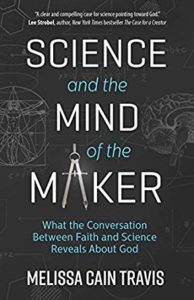 Faith & Science
Faith & Science
 Intelligent Design
Intelligent Design
Melissa Cain Travis Introduces the “Maker Thesis”


What amazing progress science — and especially medicine — has made over the past century or two!

Consider surgery today. Physicians perform a myriad of different types of procedures, and patients enjoy a high likelihood of survival. Or, on a related note — if you or a loved one needs blood or an organ donation, this is within the realm of possibility! Here in the United States, you do not have to die because your liver or kidneys stop functioning.
Childbirth is also so much safer for the mother and the baby. And life expectancies overall have been rising around the world as better hygiene and technology advance. Our ancestors would be astonished.
Certainly, in contemplating the achievements of research and medicine, we are right to feel surprised, humbled, or ecstatic. In her new book, Science and the Mind of the Maker, Melissa Cain Travis argues that wonder is in order, all the more so, when we think about the Source of science itself. She presents a compelling case for Christian theism based on design in the universe, demonstrating that the natural world points to a beauty beyond itself.
What Is the Maker Thesis?
Travis, who teaches at Houston Baptist University, defines the theme of her book as the “Maker Thesis.” What is this?
[C]ertain discoveries of the natural sciences support the inference that there is a Mind behind the universe with whom we share kinship, and suggest that this Mind intended the success of the natural sciences.
So science reveals a transcendent mind, and mind enables science.
In the prologue, Travis explains the inspiration behind the book’s title. She read The Mind of the Maker, by the English novelist Dorothy Sayers. Travis found this from the book poignant and inspiring: “As soon as the mind of the maker has been made manifest in a work, a way of communication is established between other minds and his.” Travis reflects, “Upon reading Sayers’ words, it occurred to me that this is certainly true of the most magnificent of all creations — the cosmos. Our world is a masterpiece that can be appreciated both aesthetically and intellectually; this includes scientific exploration as well as philosophical and theological reflection.”
I am a Christian too, and so I heartily agree with all of Travis’s message in Science and the Mind of the Maker. However, those who do not share these beliefs should still appreciate the broader theme of intelligent design and the scientific evidence for it.
Travis begins by exploring historical perspectives on the relationship between faith and science. She then delves into six areas of scientific discovery supporting the Maker Thesis. Along the way, she discusses the underpinnings of the scientific revolution.
Travis invites her readers to think philosophically: “Instead of asking whether or not science proves God, the correct question to ask is whether or not his existence makes better sense of the available evidence.”
Evidence for the Maker Thesis
She brings in the writings of scientists such as Johannes Kepler (“Kepler said, ‘The chief aim of all investigations of the external world should be to discover the rational order which has been imposed on it by God, and which he revealed to us in the language of mathematics’”), modern thinkers in the intelligent design movement, prominent atheists, scientists like Ernst Mayr, philosophers, and more.
How does life’s code, found in DNA, point to the Maker? In her chapter “The Language of Life: The Marvels of DNA,” Travis provides a detailed but concise overview of biological information. After earning her bachelor’s degree in biology, she spent five years doing bench science in biotechnology and pharmacy. This scientific fluency is especially evident as she explains how DNA stores information, and how transcription and translation occur in the cell. This chapter also covers various origin-of-life scenarios, junk DNA and ENCODE, and the fields of bioinformatics and biomimicry.
Aliens and Armistice Day
Can mere material explanations account for all we see? Many historical figures appearing in Travis’s work grappled with that question. For example, in the chapter on physics, she shares an anecdote from physicist Arthur Eddington on the difference between physical causes and meaning — focusing on Britain’s two minutes of silence for Armistice Day:
He suggested imagining a group of scientifically inclined aliens visiting England to study sound phenomena. They arrive on Armistice Day…. The extraterrestrial scientists would be able to give a full account of all the natural forces at work; they would determine that “[t]he noise ceased because the traffic stopped; each car stopped because a brake applied the necessary friction; the brake was worked mechanically by a pedal; the pedal by a foot; the foot by a muscle; the muscle by mechanical or electrical impulses travelling along a nerve.” Yet this physical understanding of deterministic cause and effect would not explain why there were two minutes of silence because that has to do with the informational content of the thoughts of the humans involved — what Eddington called the significance of the silence. He said, “The more complete the scientific explanation of the silence the more irrelevant that explanation becomes to our experience.”
I think Michael Egnor and our friends at the Bradley Center would appreciate that image!
Science and the Mind of the Maker would be a great book for those who want to look beyond the latest scientific discoveries to the meaning of it all. Perhaps this could be a first or second book someone might read on origins science, before jumping into a volume specifically on biology or cosmology.
Photo credit: Joel Penner, via Flickr (cropped).
